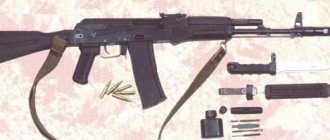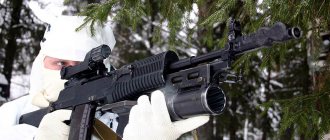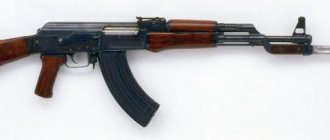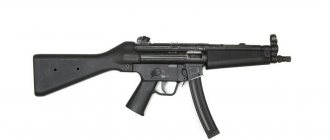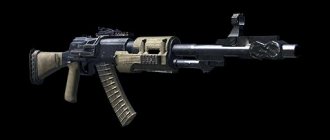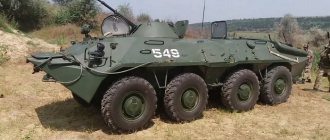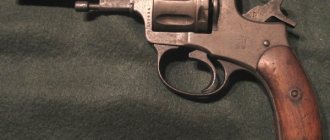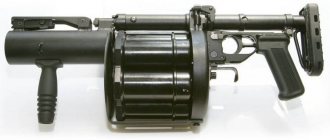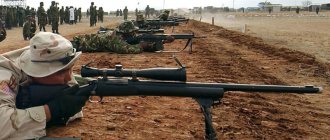Many have probably heard the expression “weapon of victory.” It is important in the history of the Soviet people. This expression united all types of weapons that helped our country in the victory over the Nazis, and also became real symbols of the Russian soldier. This also includes the T-34 tank, an anti-tank rifle, the legendary Katyusha multiple rocket launcher and, of course, the Shpagin submachine gun, aka “PPSh 41” - an assault rifle, a device, drawing and description of which are given in this text.
Story
From the experience of the war in 1939-1940 between the USSR and Finland and the Degtyarev submachine gun then in service, a certain fact became clear. It consisted in the fact that the Red Army needed to be equipped with automatic models and, accordingly, organize their mass production. “PPD-40” and “PPD-38” (Degtyarev submachine guns) were not suitable for such purposes, since they were labor-intensive and required a considerable amount of machine equipment for their production. They also had a shortage of materials and high costs. To replace the PPD, it was necessary to develop a new, cheapest and simplest submachine gun. This question was important.
In 1940, a competition was announced for the invention of a new submachine gun. The tests identified two main rivals. They turned out to be B. G. Shpitalny and G. S. Shpagin. Their models were quite promising. Shpagin won. Its version was adopted for service on December 21, 1940. Its full name was: “Submachine gun of the Shpagin system 7.62 mm mod. 1941 (automatic machine “PPSh 41”).” This is a reliable fact.
The “PPSh 41” - an assault rifle, a device whose drawing and description are given in the text below, went into mass production in the autumn of 1941. Namely, during the climax of the war, when the Red Army was in great need of such weapons. Due to the fact that such a device as the PPSh assault rifle had a simple design, did not use alloy steel and complex special tools, its production was launched at many enterprises in the country that had not previously specialized in weapons production.
The bulk of the parts of such weapons as the PPSh assault rifle were manufactured using the cold stamping method using electric and spot welding. The most complex and expensive part was the drum magazine. It was borrowed from “PPD”, which had a lot of complaints during operation. This slightly delayed the release of such weapons as the “PPSh” - an assault rifle, the drawings of which are presented below for review. After modernization, the drum magazine was replaced with a sector capacity of 35 rounds, and the corresponding sight was replaced with a reversible one, having a firing range of 100 and 200 m. During the war years, about 5.4 million Shpagin submachine guns were produced. The automatic operation of this weapon is due to the recoil of the free shutter. When firing, the barrel bore was locked by the mass of the free bolt, which was pressed by a spring (reciprocating action).
The design of the trigger-type mechanism was such that thanks to it it was possible to fire both single shots and a machine gun burst. The removable drum-type magazine was designed for 71 rounds, as in the Degtyarev submachine gun (“PPD”). The open-type aiming devices consisted of a sector sight and a front sight. The slide-type safety is located on the bolt handle. This was an important detail. Also in this case there was a slider-type fire mode switch.
Cultural significance of PCA
Along with the legendary “Katyusha” and the three-line Mosin, the PPSh-41 is strongly associated with the weapon of victory of the Great Patriotic War.
The image of a soldier with a machine gun is depicted on numerous historical sites and monuments. Soviet, modern Russian and foreign films show the image of a fighter fighting with this weapon in his hands against the enemy.
This weapon is also the hero of numerous computer games. In them you can run around the fields of virtual war with PPSh at the ready. For people who want to feel the real weight of the PPSh-41, there are prefabricated models made of wood. TARG products are especially popular
Of course, the PPSh is no longer in service with the troops, but it left its mark on history and was, if not the main, then one of the main types of weapons of the Soviet soldier during the Great Patriotic War.
Design
It is a “PPSh” automatic firearm. It is designed for firing in bursts and single shots. Automation works due to the free recoil of the shutter. This is an important property in this case. In other words, reloading and extraction of the cartridge case occurs after the shot due to the return of the loose bolt. Fire is fired from the rear sear, that is, before the shot, the bolt is in the rear extreme position. Then, after descending, he goes forward, after which he fires the cartridge. The primer is pierced at the moment the last process is completed. The shutter does not lock during firing.
This scheme is often used in the development of devices such as submachine guns. For example, the Israeli-made Uzi works on a similar principle. Although absolutely simple, such a solution requires the use of a massive bolt, which increases the entire mass of the weapon. In addition, a weapon that uses a similar reloading scheme can fire due to a strong blow, for example, when falling. If, due to an impact, the bolt rolls from the front extreme (unfixed) position along the guides further than the cartridge feed window from the magazine or from the rear extreme position, it will break off the stopper.
As in Degtyarev’s weapons, such a device as the PPSh assault rifle has: a receiver, which is fused with the barrel casing, a free massive bolt with a safety lock on the loading handle, and a disk magazine. He also has a wooden stock. But with all this, the PPSh-automatic is more technologically advanced. In this model, only the barrel needs precision mechanical processing, and the bolt was made on a lathe with further rough milling. In weapons such as the PPSh (automatic machine), the production of almost all other metal parts can be done by stamping. Here, the barrel casing has a recoil compensator at its front end. That is, in this case there is a beveled plate with a hole for the bullet to pass through. There are through windows on the sides of the casing. Thanks to the reactive action of powder gases when fired, they significantly reduce the effect of recoil and “lifting” of the barrel upward. The scope of this model has only 2 positions. Namely - 200 and 100 m. Since 1942, the PPSh began to be equipped not with a disk magazine, but with a sector (box-shaped) magazine for 35 rounds.
This was dictated by certain conditions. Namely, the fact that disk-type stores were complex to produce and less reliable. They also demanded adjustments for a specific instance of the machine gun. That is, this part from another similar “PPSh” might not fit. Judging by military photographs, box-type magazines have been seen in troops only since 1944. Next, we will consider the device of the PPSh machine gun in more detail.
Advantages and disadvantages
Advantages:
- Simplicity of design, low cost. This is what made it possible to put the machine gun into production in the shortest possible time and arm the soldiers of the Red Army;
- High combat effectiveness. Extremely high rate of fire, a record among submachine guns of that period. For close combat - “lethal weapon”. What the bullet could not destroy could be finished off with a heavy birch butt;
- High muzzle energy, lethal and penetrating effect of the bullet. Even today, a PPSh bullet is capable of penetrating class B1 body armor.
- The effective firing range of the PPSh is almost 1.5 times higher than the German MP-38/40.
Red Army soldier in Berlin
For the Red Army, this was a very successful model of automatic small arms. Its effectiveness was so high that the Germans willingly exchanged their MP-40 for a Soviet machine gun.
But there were some shortcomings, most of which were eliminated during operation:
- The high rate of fire for the young warrior, who released the entire magazine in a matter of minutes, could result in death. The fighters called the PPSh a “cartridge eater”;
- Inconvenient and heavy design. With a loaded magazine, the weight was 5.3 kg, plus spare ammunition. This was partially solved by using a carob magazine, which was lighter but of smaller volume;
- Each sample is individual. With the help of cold stamping you can maintain a high production rate, but the disadvantage is the uniqueness of each magazine - they are not interchangeable. Since three magazines are attached to the machine gun, this is a serious problem;
- Due to the low reliability of the fuse, spontaneous discharge is possible upon impact or fall.
Despite its shortcomings, the machine gun was a formidable weapon at that time.
Trunk
Inside this part there is a channel with four grooves. They curl up from left to right. There is also a chamber with a bullet entrance. It has a certain bevel at the bottom. This is to set the direction of movement of the cartridge into the chamber.
This trunk contains on the outside:
- The front part is rounded. This is to protect against nicks.
- Thickened part. For placement in a receiver box.
- A semicircular notch on the thickened part. This is to secure the barrel in the appropriate box.
- The protrusion is circular. In order to limit the process of barrel advancement when returning to place. This also reduces the perception of bolt shock.
Receiver
This element is the base. It contains the following details:
- Namushnik with a front sight.
— Sight.
— Receiver box latch.
- Swivel swivel.
The front part of the receiver serves as a casing, and the rear part serves as the bolt box cover.
In general, the receiver consists of:
— The base of the front sight for attaching a flywheel to it.
— Swivels for attaching a shoulder belt.
- Sight pads.
— Inserts for guiding the barrel.
— Front inclined plane of the casing. It is a muzzle brake.
— Longitudinal cutouts on the casing. This is to improve and facilitate air circulation.
— Windows in the muzzle brake area to provide exit for powder gases.
— Transverse hole for the connecting axis.
— Windows for ejecting cartridges.
— Latch spring stop.
- Bottom ledge. This is to limit the drop in the rear receiver area.
— Cutouts for fuse.
— Two side ledges (to limit the movement of the latch).
— Cutout for the bolt handle.
Exploitation
As mentioned above, the PPSh was mass-produced almost from the first days of the war. The first machine guns were assembled in the workshops of the Zagorsky (today the city of Sergiev Posad) plant, where it was originally planned to produce PPD.
Despite this fact, weapons did not become widespread immediately. The assault rifle received a leading role in the armament of the Red Army only in 1942. By the end of the war, more than half of the personnel of the rifle units had a submachine gun.
The PPSh largely determined the tactics of combat by Soviet units. Taking into account the performance characteristics of the weapon, the emphasis was on dense firing along the entire line of defense. Firing accuracy was usually not taken into account.
In the armies of Western countries, priorities were different. For example, in the USA the emphasis was placed precisely on the accuracy of shooting with single cartridges of high destructive power. This weapon was switched to automatic mode, but it was assumed that burst fire would be a last resort, used only in desperate situations.
Receiver latch
This element consists of the following parts:
- Cap.
- Springs.
- Hairpins.
The cap has: a hook with an inclined plane; the upper protrusion is semicircular; 2 side holes for the pin to pass through; bends, thanks to which its movement is directed and its forward movement is limited; notch on the back for ease of opening.
The latch spring is a unique part. It performs a specific function. In this case it is a short cylindrical coil spring.
Mass production
The first PPSh began to appear on the fronts only at the end of 1941. The vast majority of parts were stamped, and were made according to patterns, on the press equipment of almost any plant. The remaining components were produced on lathes or by milling.
If we consider the situation as a whole, then the creation of one PCA took half as much time and money as it did to create a PDS. This feature made it possible to collect about 1,500,000 copies in just a year. The cost of PPSh during mass production did not exceed 120 rubles.
Shutter box
This item has:
— Peculiar lugs for connection with the receiver.
— A cutout for a store with a window.
— A vertical groove for the magazine latch.
— A clip for connection with the trigger box and the front part of the stock.
- A window for the disconnector.
— A hole for the magazine latch axis.
— A window for the trigger-type lever sear.
— An oval hole for the protrusion located in the back of the trigger box.
- Window (to engage the receiver latch).
— A tail with a hole for the corresponding screw.
— Window for the guide rod.
You should also know that inside the bolt box there is a reflector attached to its front part. It has a certain rigidity.
Description of the cartridge feed mechanism
Everything is quite simple here. The supply of cartridges to the chamber is ensured by a rammer located in the bolt and a magazine borrowed from the PPD.
Next is the mechanism that locks the stem canal. In this case there is also nothing complicated. Locking the barrel channel of a weapon such as a PPSh assault rifle is carried out due to the bolt mass and the pressing force of a reciprocating spring.
Photo gallery from the museum
Real photos of the PPSH 41 assault rifle, a museum example that was found on the battlefields. The PPSh weapon dates back to 1942 and has the number VG390mmg
Don't forget to leave your comments on the site and share your opinion.

